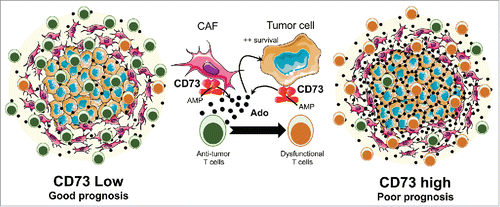Figures & data
Figure 1. High CD73 expression in high-grade serous ovarian cancers promotes tumor cell survival and immune escape. CD73 expression on both tumor cells and cancer-associated fibroblasts (CAFs) can be induced in the ovarian tumor microenvironment (TME). When CD73 is highly expressed, adenosine accumulates in the TME and mediates immunosuppressive effects on antitumor immune cells, such as CD8+ T cells. Extracellular adenosine also promotes ovarian cancer cell survival in an autocrine or paracrine manner. Hence, HGSC patients with high levels of CD73 in the TME have a worse prognosis and show impaired CD8+ T cell-mediated antitumor immunity. Conversely, patients with low levels of CD73 have a better prognosis associated with functional antitumor CD8+ T cells. Ado: Adenosine. AMP: Adenosine monophosphate.

